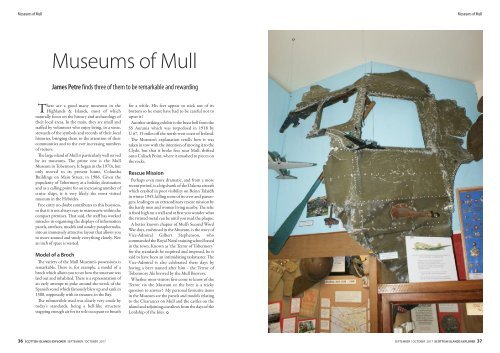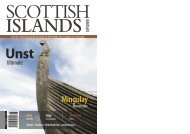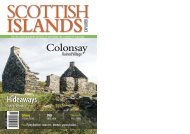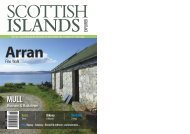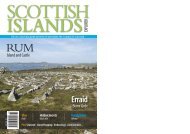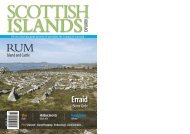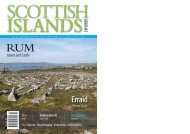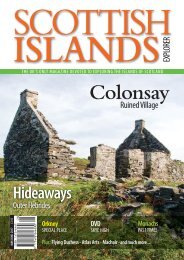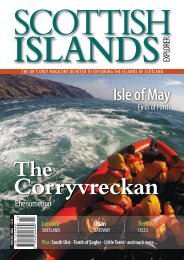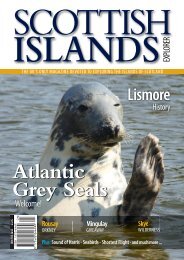You also want an ePaper? Increase the reach of your titles
YUMPU automatically turns print PDFs into web optimized ePapers that Google loves.
Museums of Mull<br />
Museums of Mull<br />
Museums of Mull<br />
James Petre finds three of them to be remarkable and rewarding<br />
There are a good many museums in the<br />
Highlands & <strong>Islands</strong>, most of which<br />
naturally focus on the history and archaeology of<br />
their local areas. In the main, they are small and<br />
staffed by volunteers who enjoy being, in a sense,<br />
stewards of the symbols and records of their local<br />
histories, bringing them to the attention of their<br />
communities and to the ever increasing numbers<br />
of visitors.<br />
The large island of Mull is particularly well served<br />
by its museums. The prime one is the Mull<br />
Museum in Tobermory. It began in the 1970s, but<br />
only moved to its present home, Columba<br />
Buildings on Main Street, in 1986. Given the<br />
popularity of Tobermory as a holiday destination<br />
and as a calling point for an increasing number of<br />
cruise ships, it is very likely the most visited<br />
museum in the Hebrides.<br />
Free entry no doubt contributes to this busyness,<br />
so that it is not always easy to manoeuvre within the<br />
compact premises. That said, the staff has worked<br />
miracles in organising the displays of information<br />
panels, artefacts, models and sundry paraphernalia,<br />
into an immensely attractive layout that allows you<br />
to move around and study everything closely. Not<br />
an inch of space is wasted.<br />
Model of a Broch<br />
The variety of the Mull Museum’s possessions is<br />
remarkable. There is, for example, a model of a<br />
broch which allows you to see how the structure was<br />
laid out and inhabited. There is a representation of<br />
an early attempt to poke around the wreck of the<br />
Spanish vessel which famously blew up and sank in<br />
1588, supposedly with its treasure, in the Bay.<br />
The submersible used was clearly very crude by<br />
today’s standards, being a bell-like structure<br />
trapping enough air for its sole occupant to breath<br />
for a while. His feet appear to stick out of its<br />
bottom so he must have had to be careful not to<br />
upset it!<br />
Another striking exhibit is the brass bell from the<br />
SS Aurania which was torpedoed in 1918 by<br />
U 67, 15 miles off the north-west coast of Ireland.<br />
The Museum’s explanation retells how it was<br />
taken in tow with the intention of moving it to the<br />
Clyde, but that it broke free near Mull, drifted<br />
onto Caliach Point, where it smashed to pieces on<br />
the rocks.<br />
Rescue Mission<br />
Perhaps even more dramatic, and from a more<br />
recent period, is a big chunk of the Dakota aircraft<br />
which crashed in poor visibility on Beinn Talaidh<br />
in winter 19<strong>45</strong>, killing some of its crew and passengers,<br />
leading to an extraordinary rescue mission by<br />
the hardy men and women living nearby. The relic<br />
is fixed high on a wall and at first you wonder what<br />
the twisted metal can be until you read the plaque.<br />
A better known chapter of Mull’s Second Word<br />
War days, enshrined in the Museum, is the story of<br />
Vice-Admiral Gilbert Stephenson, who<br />
commanded the Royal Naval training school based<br />
in the town. Known as ‘the Terror of Tobermory’<br />
for the standards he required and imposed, he is<br />
said to have been an intimidating taskmaster. The<br />
Vice-Admiral is also celebrated these days by<br />
having a beer named after him - the Terror of<br />
Tobermory Ale brewed by the Mull Brewery.<br />
Whether most visitors first come to know of the<br />
Terror via the Museum or the beer is a tricky<br />
question to answer! My personal favourite items<br />
in the Museum are the panels and models relating<br />
to the Clearances on Mull and the castles on the<br />
island and adjoining coastlines from the days of the<br />
Lordship of the Isles.<br />
36 SCOTTISH ISLANDS EXPLORER SEPTEMBER / OCTOBER <strong>2017</strong><br />
SEPTEMBER / OCTOBER <strong>2017</strong> SCOTTISH ISLANDS EXPLORER 37


